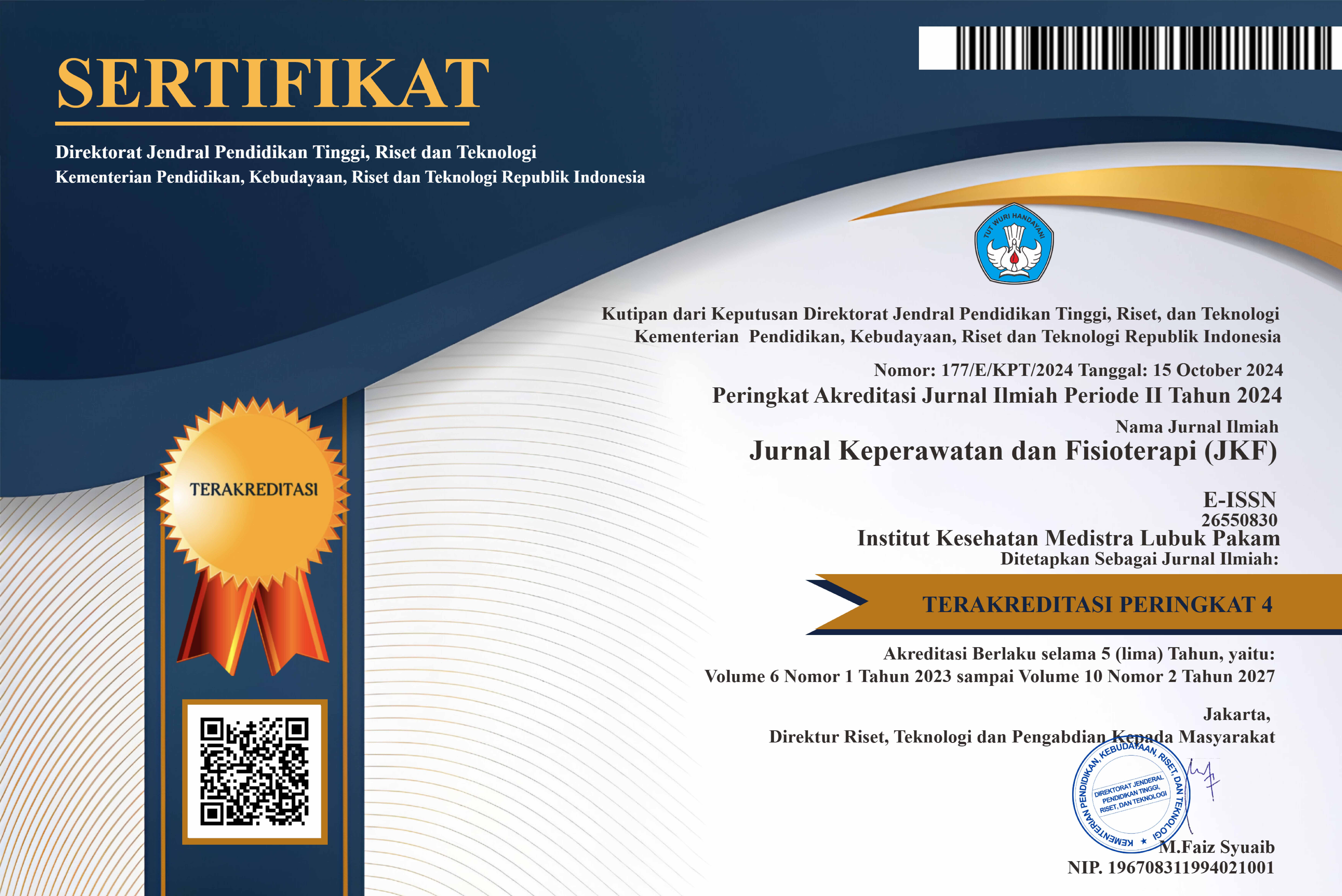Inhibitory effect of Transcranial Magnetic Stimulation (TMS) in the case of stroke: literature study
DOI:
https://doi.org/10.35451/jkf.v7i1.2277Keywords:
TMS, inhibisi, strokeAbstract
Background: Transcranial Magnetic Stimulation (TMS) is a form of non-invasive brain stimulation with the capacity to modulate cortical excitability. Low-frequency TMS (1 Hz) inhibits regional brain activity and allows contralateral cortical excitability through modulation of interhemispheric inhibition. Until now, research on low-frequency TMS that shows its inhibition on regional brain and the possibility of contralateral cortical stimulation is still very limited and not widely known. The purpose of this study was to determine the inhibitory effect of Transcranial Magnetic Stimulation (TMS) in post-stroke patients. Methods: Literature review was conducted to identify all articles that discuss the use of low-frequency TMS to determine the inhibitory effect of post-stroke patients on non-lesion areas. Databases from Hindawi, PubMed, Science Direct, and Cochrane with research types of pilot studies and randomized controlled trials published in the last 10 years by entering the keywords “Transcranial Magnetic Stimulation”, “Inhibition”, and “Stroke”. The research was conducted by systematically collecting, processing, and analyzing data. Results: Of the 505 articles identified, then selected according to the title there were 57 articles, obtained 10 articles that had abstracts according to the study. After that, the selection of articles according to the inclusion and exclusion criteria by reading the full article, there were 4 studies selected for review. 4 articles were included in this study showing motor improvement, increased functional ability, and cognitive improvement in post-stroke patients. Conclusion: TMS has beneficial effects on motor recovery in post-stroke patients with lasting effects.
Downloads
References
Johnson W, Onuma O, Owolabi M, Sachdev S. Stroke: a global response is needed. Bull World Health Organ [Internet]. 1 September 2016;94(9):634-634A. Tersedia pada: https://www.ncbi.nlm.nih.gov/pmc/articles/PMC5034645/pdf/BLT.16.181636.pdf/
Duncan PW. Outcome measures in stroke rehabilitation. In 2013. hal. 105–11. Tersedia pada: https://linkinghub.elsevier.com/retrieve/pii/B9780444529015000095
Hatem SM, Saussez G, della Faille M, Prist V, Zhang X, Dispa D, et al. Rehabilitation of Motor Function after Stroke: A Multiple Systematic Review Focused on Techniques to Stimulate Upper Extremity Recovery. Front Hum Neurosci [Internet]. 13 September 2016;10. Tersedia pada: http://journal.frontiersin.org/Article/10.3389/fnhum.2016.00442/abstract
Rose DK, Patten C, McGuirk TE, Lu X, Triggs WJ. Does Inhibitory Repetitive Transcranial Magnetic Stimulation Augment Functional Task Practice to Improve Arm Recovery in Chronic Stroke? Stroke Res Treat [Internet]. 2014;2014:1–10. Tersedia pada: http://www.hindawi.com/journals/srt/2014/305236/
Kakuda W, Abo M, Shimizu M, Sasanuma J, Okamoto T, Yokoi A, et al. A multi-center study on low-frequency rTMS combined with intensive occupational therapy for upper limb hemiparesis in post-stroke patients. J Neuroeng Rehabil [Internet]. 20 Desember 2012;9(1):4. Tersedia pada: https://jneuroengrehab.biomedcentral.com/articles/10.1186/1743-0003-9-4
Sheng R, Chen C, Chen H, Yu P. Repetitive transcranial magnetic stimulation for stroke rehabilitation: insights into the molecular and cellular mechanisms of neuroinflammation. Front Immunol [Internet]. 22 Mei 2023;14. Tersedia pada: https://www.frontiersin.org/articles/10.3389/fimmu.2023.1197422/full
Eldaief MC, Dickerson BC, Camprodon JA. Transcranial Magnetic Stimulation for the Neurological Patient: Scientific Principles and Applications. Semin Neurol [Internet]. 25 April 2022;42(02):149–57. Tersedia pada: http://www.thieme-connect.de/DOI/DOI?10.1055/s-0041-1742265
Fisicaro F, Lanza G, Grasso AA, Pennisi G, Bella R, Paulus W, et al. Repetitive transcranial magnetic stimulation in stroke rehabilitation: review of the current evidence and pitfalls. Ther Adv Neurol Disord [Internet]. 25 Januari 2019;12:175628641987831. Tersedia pada: http://journals.sagepub.com/doi/10.1177/1756286419878317
Le Q, Qu Y, Tao Y, Zhu S. Effects of Repetitive Transcranial Magnetic Stimulation on Hand Function Recovery and Excitability of the Motor Cortex After Stroke. Am J Phys Med Rehabil [Internet]. Mei 2014;93(5):422–30. Tersedia pada: https://journals.lww.com/00002060-201405000-00008
Emara TH, Moustafa RR, ElNahas NM, ElGanzoury AM, Abdo TA, Mohamed SA, et al. Repetitive transcranial magnetic stimulation at 1Hz and 5Hz produces sustained improvement in motor function and disability after ischaemic stroke. Eur J Neurol [Internet]. 8 September 2010;17(9):1203–9. Tersedia pada: https://onlinelibrary.wiley.com/doi/10.1111/j.1468-1331.2010.03000.x
Tretriluxana J, Thanakamchokchai J, Jalayondeja C, Pakaprot N, Tretriluxana S. The Persisted Effects of Low-Frequency Repetitive Transcranial Magnetic Stimulation to Augment Task-Specific Induced Hand Recovery Following Subacute Stroke: Extended Study. Ann Rehabil Med [Internet]. 31 Desember 2018;42(6):777–87. Tersedia pada: http://www.e-arm.org/journal/view.php?doi=10.5535/arm.2018.42.6.777
Sharma H, Vishnu VY, Kumar N, Sreenivas V, Rajeswari MR, Bhatia R, et al. Efficacy of Low-Frequency Repetitive Transcranial Magnetic Stimulation in Ischemic Stroke: A Double-Blind Randomized Controlled Trial. Arch Rehabil Res Clin Transl [Internet]. Maret 2020;2(1):100039. Tersedia pada: https://linkinghub.elsevier.com/retrieve/pii/S2590109520300021
American Stroke Association. About Stroke [Internet]. 2020. Tersedia pada: https://www.stroke.org/en/about-stroke
Hama S, Yoshimura K, Yanagawa A, Shimonaga K, Furui A, Soh Z, et al. Relationships between motor and cognitive functions and subsequent post-stroke mood disorders revealed by machine learning analysis. Sci Rep [Internet]. 11 November 2020;10(1):19571. Tersedia pada: https://www.nature.com/articles/s41598-020-76429-z
Johansson BB. Current trends in stroke rehabilitation. A review with focus on brain plasticity. Acta Neurol Scand [Internet]. Maret 2011;123(3):147–59. Tersedia pada: https://onlinelibrary.wiley.com/doi/10.1111/j.1600-0404.2010.01417.x
Sung WH, Wang CP, Chou CL, Chen YC, Chang YC, Tsai PY. Efficacy of Coupling Inhibitory and Facilitatory Repetitive Transcranial Magnetic Stimulation to Enhance Motor Recovery in Hemiplegic Stroke Patients. Stroke [Internet]. Mei 2013;44(5):1375–82. Tersedia pada: https://www.ahajournals.org/doi/10.1161/STROKEAHA.111.000522
Gersner R, Kravetz E, Feil J, Pell G, Zangen A. Long-Term Effects of Repetitive Transcranial Magnetic Stimulation on Markers for Neuroplasticity: Differential Outcomes in Anesthetized and Awake Animals. J Neurosci [Internet]. 18 Mei 2011;31(20):7521–6. Tersedia pada: https://www.jneurosci.org/lookup/doi/10.1523/JNEUROSCI.6751-10.2011
Downloads
Published
Issue
Section
License
Copyright (c) 2024 Umi Budi Rahayu Rahayu, Siti Raihani

This work is licensed under a Creative Commons Attribution 4.0 International License.
Copyright in each article is the property of the Author.


























